PEZ review: Tempesta and Nano Flex wet weather gear
Castelli’s new Tempesta line promises 100% waterproof protection with lightweight, extreme weather gear made from new fabrics from eVent & OutDry – here’s a closer look.
By Richard Pestes, PezCyclingNews.com
I talked to Castelli’s top product dawg Steve Smith while he was driving to his home in Bassano del Grappa on the same road where Fausto Coppi lost the 1950 Giro after touching wheels with another rider caused him to crash and break his hip. Living in Europe & Italy for many years has allowed Steve enviable exposure to road cycling in the sport’s heartland. It’s also given him easy access to the best textile mills and makers of technical fabrics, and daily access to the factory where he can oversee production of new items.
It boils down to ‘zero-loss’ from concept to design to production. And that’s a big reason why Castelli has become so successful in the category. Another reason is that they just keep on pushing the envelope and setting new boundaries for performance cycling apparel. The newest wet weather line in stores now for winter, is the Tempesta line.

The Tempesta jacket, Nano Flex Pro Bibtight, Tempesta gloves and shoecovers. I shot this with a flash, which shows the hi-vis reflective bits on each piece.
Tempesta Rain Jacket – $299 (€329,95)
In the world of technical wet weather riding gear, Castelli drove a big stake into the sand and gained a ton of street cred with its original Gabba jersey. Intro’d to the pro peloton on the backs of Team Garmin a couple seasons back, it was the original breakthrough jacket for a high end water-protection. It came at a time when standard issue rain gear was bulky and flappy, with puffy sleeves and no stretch.

Thor Hushovd wearing the first Gabba jersey & Nano Flex armwarmers at Kuurne-Brussells-Kuurne in 2010’s abysmal conditions.
The Gabba was different from pretty much every other rain jacket at the time. Cut to fit a racer’s build, it was the first rain-gear that offered some aero advantage in the wet while keeping you dry. It was so good that pro teams not even sponsored by Castelli were wearing it when the weather got bad. With success in wet weather protection established, and with wet weather riding around Castelli’s Italian base an undeniable part of fall & winter, the only question left to ask was “what’s next?”
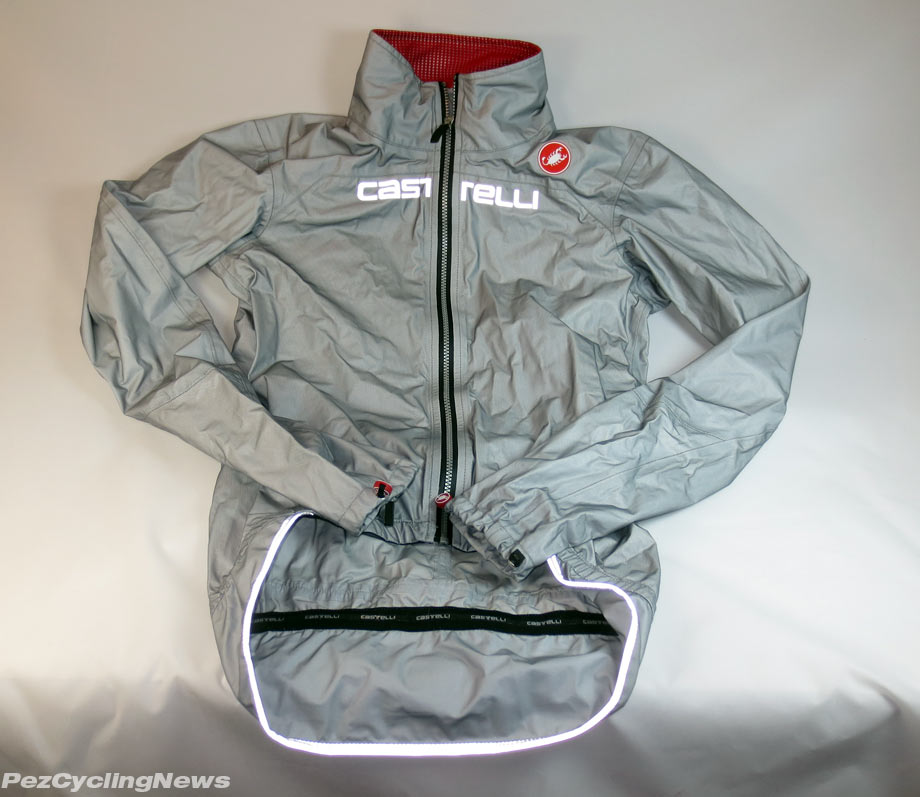
From here the Tempesta rain jacket and line were born to offer head to toe wet weather coverage that allows the body to breathe, is 100% water proof, and light weight enough that you don’t have to think twice about choosing it.
Oh – and there’s one more benefit, as Steve told me – it makes riding in the rain “actually fun”.
His words – not mine.

The collar is a a full 3.5 inches tall, including almost two inches of added soft mesh to add comfort and airflow around the neck.
The Tempesta jacket is essentially a lightweight shell (my tester weighed just 194 grams) that works as both a carry along (it’s small enough to easily fit into a jersey pocket) or your main rain piece.
It’s made mostly of two different fabrics – eVent Waterproof fabric is the main game here – used for the front and main body panels, it’s water proof and breathes well. The physics of stretchy fabrics preclude them from being waterproof (you know – when a fabric stretches it opens tiny spaces between the woven threads that allow moisture to pass through). Castelli works around this by designing a form fitting jacket, sewn together as several panels to give it the rider’s on the bars’ shape, and using a second fabric on the back of the sleeves & lower back that does stretch, to allow better fit, more comfort, and less bulk.

Inside the seams are taped for complete wet weather lock-out.
Like other modern rain-repelling fabrics, the eVent lets sweat molecules out but keeps water from getting in. It’s a 3-layer fabric that uses a 15 micron thick teflon membrane whose water repulsion is maintained by ironing or tumbling dry on med low to reactivate & redistribute the chemical coating around the garment.
For now it’s available in a light shade of gray, which is a lot more visible than the ubiquitous black (that so many brands continue to make, and so many dealers continue to stock), but a hi-vis neon green is coming for next year.

Zipper is YKK® fully water proof – it’s a big one that actually slides so you can open and close it without using your teeth.
Fit is snug and racer-like as advertised. It’s been designed, shaped and sewn to fit you in the riding position, and my size Medium tester worked well over over top a long sleeve base and a short sleeve summer weight jersey. There’s not much room for more layers underneath – which makes sense since riding in weather that bad would not be advisable for anyone. Sleeves are plenty long to cover your wrists in the fully stretched reach for your tops & drops, and the cuffs feature a tabbed draw-string to cinch ’em down if the going gets really nasty.
There’s also a nice extra flap to cover your butt, that can tuck up under the jersey back if you don’t need it. The waist gripper uses a thin strip of silicone, and the front bottom of the jacket is cut higher to avoid extra bulk around the mid-section.
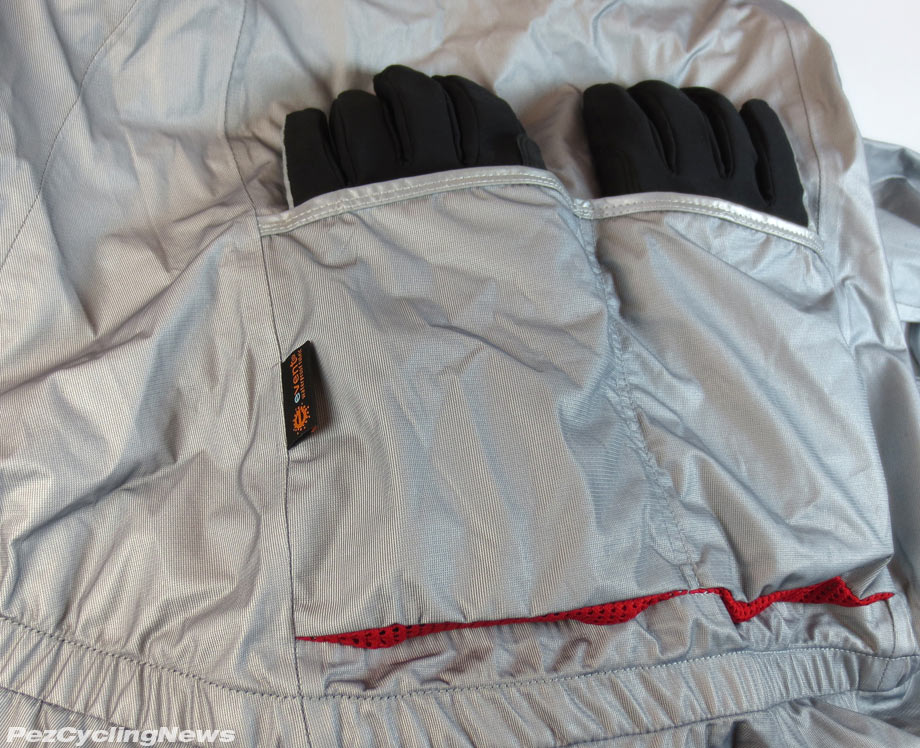
Two pockets in back are deep and roomy.
My first test day in the Tempesta was a steady drizzle, temps around 8-10C degrees, I chose a route with a lot of climbing to get my sweat on and see how I’d like the breathability. On the bike I barely knew I was wearing a rain jacket because the material is so light and soft – not crunchy and crinkly some some jackets I’ve seen. Testing breathability is always a subjective undertaking – and I sweated like I always do on a ride that involves climbing. But I noted that my base layers seemed a lot less like they been sitting in a hot sauna than with other jackets I’ve worn. Everyone has different preferences when it comes to layers, not to mention interpretation of how they perceive their body temperature and sweat levels, so your own mileage may vary.

The pockets are also well vented, so water form that massive downpour you’ll be riding in will run right on through.
The eVent website says the science of this jacket works, and my own experience supports that. The overall quality of the piece is excellent and what I’ve come to expect from Castelli. As a new item for this year, Castelli’s original production run has been bought up by dealers, so the only place to find one is at your local shop. At US$299 it’s not cheap, but in the mix with other high end rain jackets, and I’d expect this to last several seasons.
Nano Flex Pro Bibtights – $199 (€179,95)
I first tested Castelli’s original Nano Flex bibs a few seasons back, and they’ve become my go-to bib for all but the coldest days of riding. In addition being the perfect choice for most rides around PEZ HQ from November to March, they were a key item when I visited Belgium for the Spring Classics, and days can be cool, or wet, or both.
The Nano Flex fabric is a standout in wet weather protection – it’s warm, it stretches, and it does a damn fine job of repelling water, thanks to a special coating applied to the fabric itself.
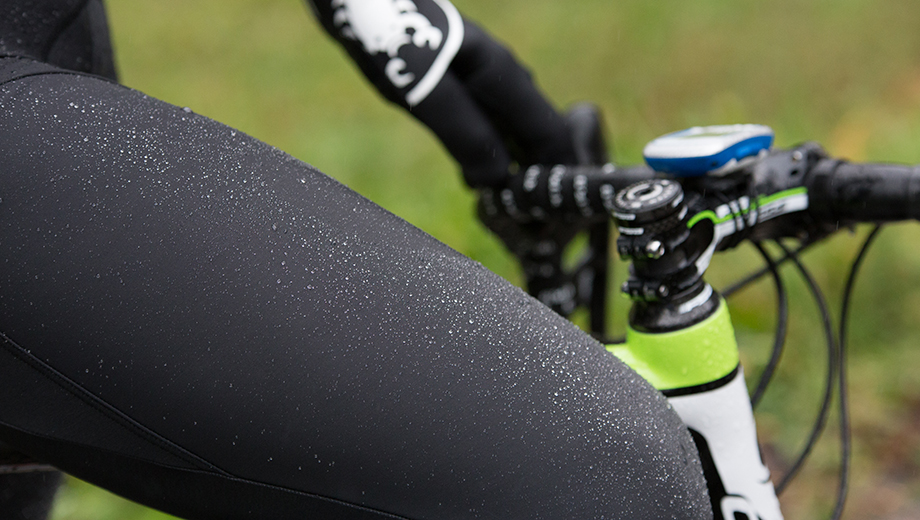
For 2015/16, the Nano Flex bibs get an upgrade with the Pro version designed for extremely wet weather. The main difference over the Nano Flex 2 bibs is the addition of an extra layer of their Nano Flex material on the thighs, knees, and seat. This doubles up on the rain protection, and also adds a nice wind blocking layer that really extends the use of these bibs to much colder days.
The chamois is their Progetto X2 – it’s used in a few other Castelli models, and is one of my favorite inserts. Instead of heating the foam insert and compressing it to different densities, which can cause the foam to prematurely break down, the multi densities here are created by shaving a single piece of foam to different thicknesses to deliver more uncompressed, springy foam where you want it, less where you don’t. Against your skin is a single smooth and flat piece of material, which is awesome because it eliminates the seams and ridges that can cause chaffing and saddle sores.
The chamois also features three gel inserts – two for the sit bones and one right behind your junk. They’re called a ‘viscous comfort zone’ and are so thin, I could not tell they were even there, which says a lot about how well they integrate with the pad. Overall the pad is a bit thicker than some others which a lot of you will appreciate the extra padding for longer rides.
The shoulder straps follow a high T-cut shape in the back, so they won’t slip down around your shoulders when riding, and are lazer cut to eliminate a seam along the edges, which makes them more comfortable. In between is a well vented three-d dot mesh that leaves the temperature regulation to your choice of base and outer layers.

But maybe my favorite feature of the Nano Flex Pro bibs is the hi-vis reflective layer added on the front of the shins. It’s a full water blocker, adding some nice protection from wheel spray to an area that is pretty much a main entry point for water into your shoes, so preventing the lower legs of any bib from getting soaked through means your feet stay dryer longer.

The shins are highly reflective – the right panel shows how much they light up when hit with light – like in this case the flash form my camera.
I’m all about the hi-vis these days, as most of you dads out there will agree, and it’s nice that you no longer have to look like a dork to be highly visible. These panels on the lower shins contain millions of microscopic glass beads that reflect light like crazy. The image above shows how reflective these panels are – the image on the right shows how they light up when light hits them – in practical terms that’s car lights.
Fit is snug – my medium sized testers required a little more effort to get on than other models, but this is likely due to the double layers of material on the thighs and butt. Once on, they felt more like a high compressions bib, and like most well made gear, the fit and felt very good while riding. I can see this becoming ny new “go-to” bib for the winter months ahead.
Tempesta Gloves – $89 (€89,95)
I counted 21 different glove models on the Castelli website, covering all seasons. When it gets down below 7-8C degrees, though I look for just one pair to handle keeping my handlers warm. The challenge is always to keep the hands warm, but not sweaty, and these Tempesta gloves could be just the ticket.
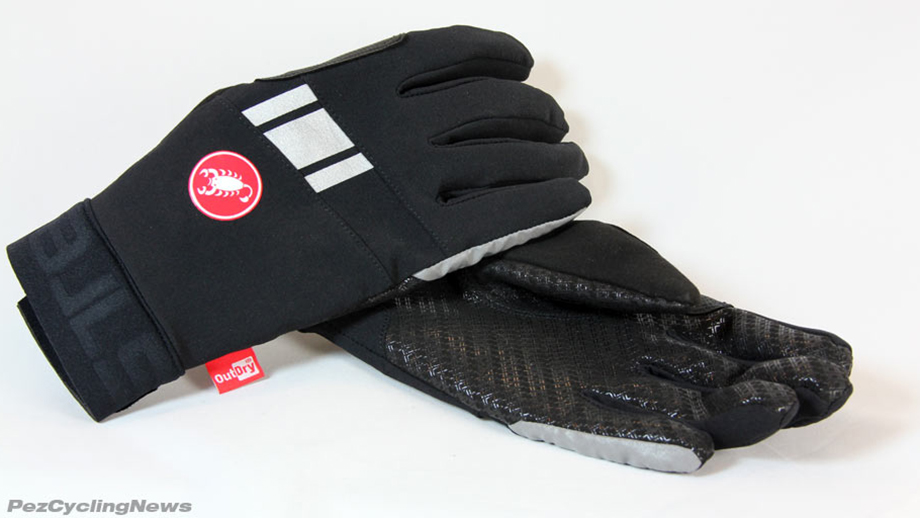
For starters, they’re billed as completely waterproof, thanks to the OutDry material. The OutDry website shows some really cool technology that shows how “the waterproof and breathable membrane is bonded directly to the external glove’s shell” to keeps the water out, but allows sweat vapors to pass through so you stay more comfortable.

The cuff is a stretchy neoprene with a wide velcro closure for plenty of adjustment at the wrists. The palm is covered with a tacky silicone pattern for maximum grip on wet bars, while the thumb-forefinger pocket is a grippy rubber layer that should stand up to a lot of winter miles. The thumb back is covered with a soft synthetic suede as the snot-wiper, and there are also a couple of hi-vis reflectors on the back and edge of the baby finger – not much but every bit helps.
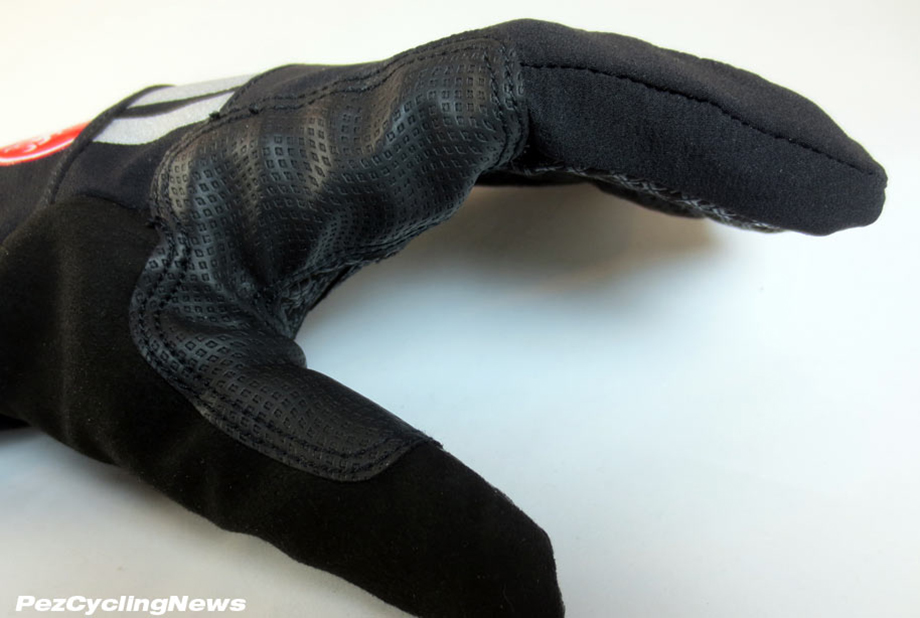
Inside the glove has a soft and warm fleece liner, setting them up for some good winter riding days.
Tempesta Shoe Cover – $99 (€99,95)
After 13 years of PEZ, my search for the ultimate wet weather shoe cover carries on. I’ve long ben a fan of basic neoprene booties like Castelli’s Diluvio models, but on really wet days, these eventually soak through, soon followed by the dreaded winter foot chills. The Tempesta shoecover promises to change all that. The main body is made from OutDry material (just like that glove you just read about) which also offers a small amount of 4-way stretch. Castelli also tells me this is the only shoecover available made from OutDry.
I reckon I’ve worn out more shoe covers and booties over the years than all my other pieces combined, and this Tempesta cover has a robustness to it that hopefully puts an end to my personal trend. The ankles are plenty tall to give good coverage above the shoe, and plenty of overlap with tights or leg warmers.
Inside the shoe is a light liner that’s designed to keep over heating to a minimum.
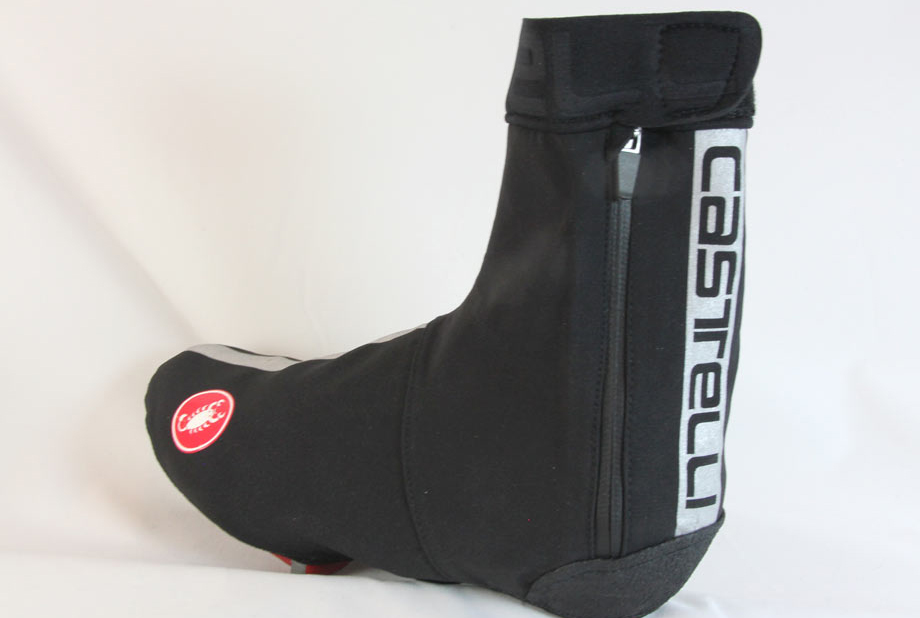
The cuff seals with neoprene just like the Tempesta glove, and the zipper is water proof and the tab tucks away nicely under the velcro cuff closure.

The most obvious point of water entry will be from underneath via this opening, but they’ve at least added an elastic seam around the footbed to help seal out water.

Underneath, the heel and toe are reinforced with Cordura that should do a decent job of protecting an area that commonly fails. And while there is some stretch to the material, it’s limited, so Castelli has opened the underside of the shoe for easier access, and added a heavy-duty velcro closure to cinch the opening closed.
Fit on my size medium testers was quite good over my size 40 shoes. The fit is snug enough that they might take a little longer to pull on than covers made with a lighter material, but my initial rides have been good. I’ve yet to actually test these in steady rain, but will update this in the coming weeks when I do. I’ve found the OutDry material does however so a good job of blocking wind, which is really the #1 enemy of warm feet.
Castelli also makes a Tempesta 3/4 pant that was not available as of this writing (and a Tempesta cap, hood and leg warmer as well) – so I’ll circle back on that one later. Overall, the Tempesta gear I tested here is impressive, the jacket is really light, but hearty enough to double as year-round rain wear. The Nano Flex Pro bibs are definitely warmer than earlier models, and the Tempesta gloves and shoecovers complete the line nicely. The use of new fabrics though for all pieces is really what takes this gear up a notch, and is worth a closer look at your local shop.
Images (except Hushovd) and words by PEZ cycling news
